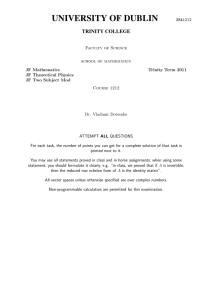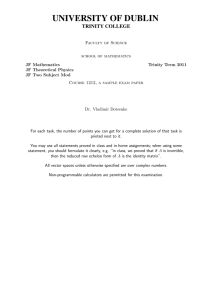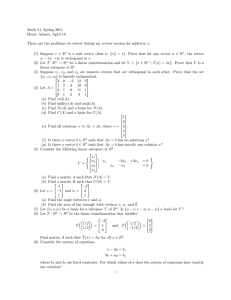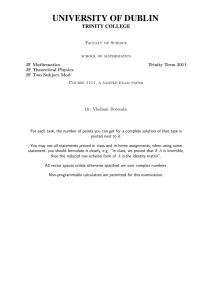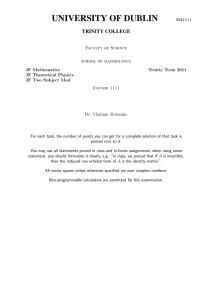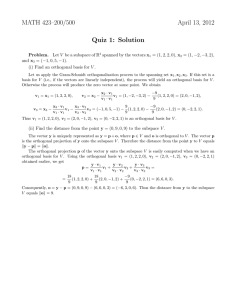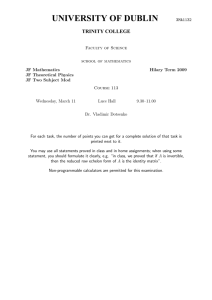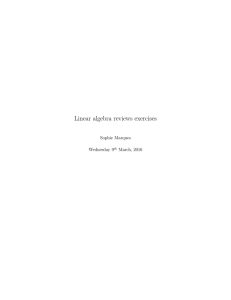UNIVERSITY OF DUBLIN TRINITY COLLEGE
advertisement
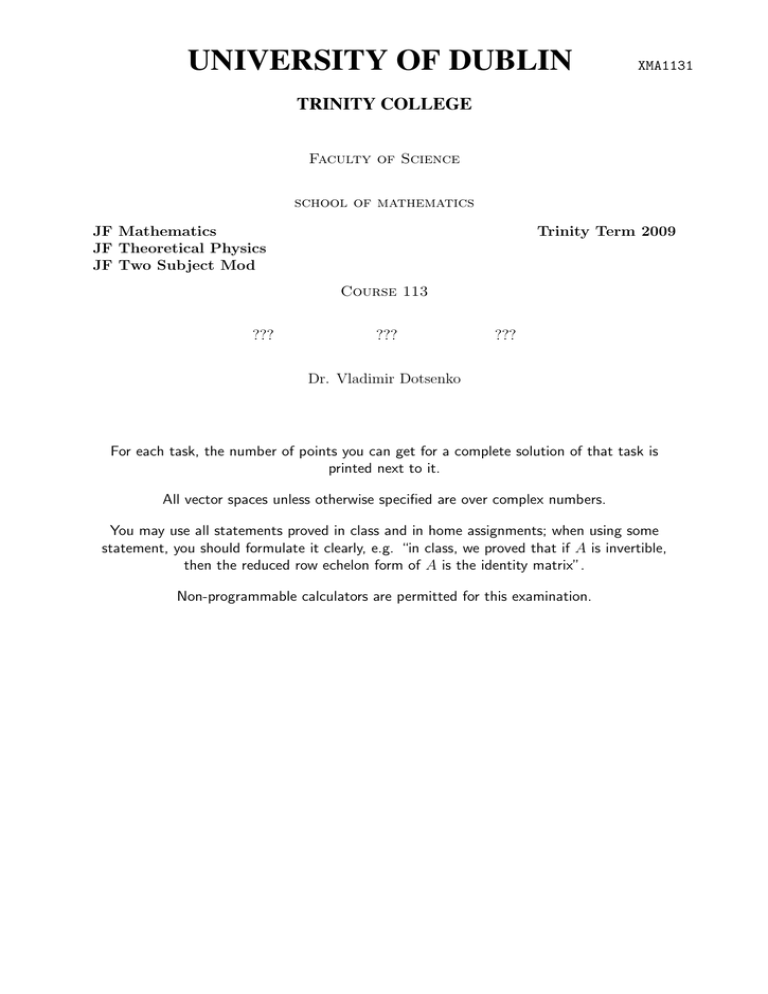
UNIVERSITY OF DUBLIN
XMA1131
TRINITY COLLEGE
Faculty of Science
school of mathematics
JF Mathematics
JF Theoretical Physics
JF Two Subject Mod
Trinity Term 2009
Course 113
???
???
???
Dr. Vladimir Dotsenko
For each task, the number of points you can get for a complete solution of that task is
printed next to it.
All vector spaces unless otherwise specified are over complex numbers.
You may use all statements proved in class and in home assignments; when using some
statement, you should formulate it clearly, e.g. “in class, we proved that if A is invertible,
then the reduced row echelon form of A is the identity matrix”.
Non-programmable calculators are permitted for this examination.
Page 2 of 3
XMA1131
1 2 3
5
1. Denote by A the matrix 2 2 3 and by b the vector −1.
3 3 3
2
(a) (5 points) List all minors and all cofactors of A, and write down the expansion of
det(A) along the second row and along the third column.
(b) (5 points) Show how to use the Cramer’s rule to solve the system Ax = b.
2. (10 points) Describe all possible values of i, j, k and l for which the term
a4k a35 ail a67 aj1 a23 a14
occurs in the expansion of a 7 × 7 determinant with coefficient −1.
3. (a) (5 points) Prove that for two square matrices A and B of the same size we always
have tr(AB) = tr(BA).
(b) (10 points) How many distinct numbers can there be among the six traces
tr(ABC), tr(ACB), tr(BCA), tr(BAC), tr(CBA), tr(CAB)?
for different choices of square matrices A, B, C of the same size? For each variant
of the answer, give an example.
−2
1
1
−1
and an invariant
4. (12 points) Is the subspace U of R4 spanned by
4
−1
1
−2
subspace of the operator A whose matrix relative to the standard basis is
0
3 −3 −1
1
3 −1 0
?
7 12 2
3
−3 −6 0 −1
Explain your answer.
Page 3 of 3
XMA1131
5. (a) (6 points) Find all eigenvalues and eigenvectors of the matrix
1 −1
.
B=
1 3
(b) (7 points) Find the Jordan normal form of the matrix B, and a matrix C which is
the transition matrix of some Jordan basis of B.
(c) (8 points) Find a formula for B n , and use it to find a closed formula for the nth
terms of the sequences {xm }, {ym } defined recursively as follows:
x0 = 1, y0 = −5,
xk+1 = xk − yk ,
yk+1 = xk + 3yk .
6. (a) (5 points) Which bases of a Euclidean space V are called orthogonal? orthonormal?
1
0
−1
(b) (5 points) Show that the f1 = 0 , f2 = −2, and f3 = 1 form a basis
4
3
2
3
of R .
(c) (7 points) Find the orthogonal basis of R3 which is the output of the GramSchmidt orthogonalisation applied to the basis from the previous question. (The
inner product on the R3 is the standard one.)
7. (a) (5 points) Write down the definition of a bilinear form on a real vector space.
Which symmetric bilinear forms are said to be positive definite?
(b) (10 points) Consider the vector space V of all polynomials in t of degree at most 2.
The bilinear form ψa on V (depending on a [real] parameter a) is defined by the
formula
Z
1
f (t)g(t)(t − a) dt.
ψa (f (t), g(t)) =
−1
Determine all values of a for which ψa is positive definite.
c UNIVERSITY OF DUBLIN 2011
